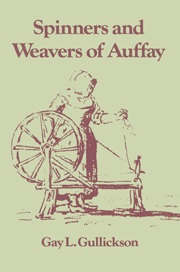 The Spinners and Weavers of Auffay
The Spinners and Weavers of Auffay Book contents
- Frontmatter
- Contents
- Preface
- 1 Introduction
- 2 The pays and the village
- 3 Proto-industrial theory and the pays de Caux
- 4 The golden age of spinning
- 5 Crisis and change in the Caux
- 6 The golden age of cottage weaving
- 7 Marriage and family in proto-industrial Auffay
- 8 Widowhood, remarriage, and the sexual division of labor
- 9 Unwed mothers and their children
- 10 Conclusions: the causes and consequences of proto-industrialization
- Appendix Vital statistics for Auffay
- Notes
- Bibliography
- Index
8 - Widowhood, remarriage, and the sexual division of labor
Published online by Cambridge University Press: 29 October 2009
- Frontmatter
- Contents
- Preface
- 1 Introduction
- 2 The pays and the village
- 3 Proto-industrial theory and the pays de Caux
- 4 The golden age of spinning
- 5 Crisis and change in the Caux
- 6 The golden age of cottage weaving
- 7 Marriage and family in proto-industrial Auffay
- 8 Widowhood, remarriage, and the sexual division of labor
- 9 Unwed mothers and their children
- 10 Conclusions: the causes and consequences of proto-industrialization
- Appendix Vital statistics for Auffay
- Notes
- Bibliography
- Index
Summary
In 1783, Jacques Etienne Quevillon married Marie Anne Moisson. He was a twenty-seven-year-old weaver and she was a twenty-eight-year-old spinner, occupations that they appear to have held consistently throughout their marriage. Nineteen months after the wedding, Marie Anne bore a daughter, Marie Anne Felicité. Four and a half years later, she bore a second child, a son named Charles Tranquille. In 1794, the five-year-old Charles Tranquille and his mother died within two weeks of each other, perhaps of a contagious disease, although the parish and civil registers for Auffay never report the cause of death. Less than four months after the death of his wife and son, and with a ten-year-old daughter to care for, Jacques Etienne married again. He was thirty-eight. His new wife, Marie Magdeleine Saunier, was four years his junior and, like Marie Anne Moisson, was a spinner.
Nineteenth-century middle-class observers of peasant life were shocked by the rapidity with which men like Jacques Etienne Quevillon remarried after the death of a spouse. In their eyes, this was proof that peasant marriages were merely economic arrangements, and that no emotional bond existed between husband and wife. Some historians have subscribed to this view and believe that peasant marriage was based purely on financial considerations.
- Type
- Chapter
- Information
- The Spinners and Weavers of AuffayRural Industry and the Sexual Division of Labor in a French Village, pp. 162 - 177Publisher: Cambridge University PressPrint publication year: 1986
